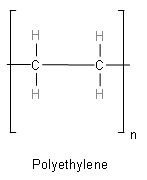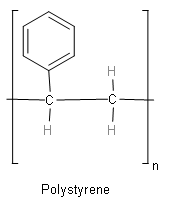Answer
39.6k+ views
Hint: This compound is also used to make Styrofoam. This is used for producing disposable plastic cutlery and dinnerware, it is harmful to both the human body if ingested and to the environment if not properly disposed of. Its expanded form is used for food containers, moulded sheets for building insulation, and packing material.
Complete step by step answer:
To answer this question, we should discuss each option.
> Polypropylene: We should know that it is a thermoplastic polymer used in a wide variety of applications. It is produced via chain-growth polymerization from the monomer propylene.
- Polypropylene is used in the manufacturing of piping systems. Polypropylene is widely used in ropes, distinctive because they are light enough to float in water. There are many applications of polypropylene. But none of the points can prove that it is used for manufacturing of thermocol.

> Polyethylene: We know that Polyethylene or polythene is the most common plastic in use today. It is used for making plastic bags, plastic films, containers including bottles, etc.

> Polystyrene: We should know that it is a synthetic aromatic hydrocarbon polymer made from the monomer known as styrene. Polystyrene can be solid or foamed. Polystyrene is an additional polymer that results when styrene monomers interconnect (polymerization). We should here note that polystyrene foams are 95-98% air and they are good thermal insulators. It has one other form that is Expanded polystyrene (EPS). It is usually white and made of pre-expanded polystyrene beads. EPS is used for food containers, moulded sheets for building insulation, and packing material either as solid blocks formed to accommodate the item being protected.

> High-density polyethylene (HDPE): We should know that it is a thermoplastic polymer produced from the monomer ethylene. It has a high strength-to-density ratio. We use HDPE fibres to make rope. It is used to make flexible HDPE pipes. It is used in a variety of applications such as in making chemical containers, folding chairs and tables, shampoo bottles and many more.

So, from the above discussion we can say that polystyrene is used to make thermocol. As we already discussed that polystyrene foams have 95-98% air. Polystyrene foam is used to make thermocol. So, option C is correct.
Note: We should know that synthetic polymers are man-made polymers. Synthetic polymers are classified into three main categories: thermoplastics, elastomers and synthetic fibres. We are already familiar with synthetic polymers such as Nylons in textiles and fabrics, Teflon in non-stick pans, Bakelite for electrical switches, polyvinyl chloride (PVC) in pipes. The plastic kits and covers are mostly made of synthetic polymers like polythene and tires are manufactured from Buna rubbers. The eight most common types of synthetic organic polymers, which are commonly found in households, are:
1) Low-density polyethylene (LDPE)
2) High-density polyethylene (HDPE)
3) Polypropylene (PP)
4) Polyvinyl chloride (PVC)
5) Polystyrene (PS)
6) Nylon, nylon 6, nylon 6,6
7) Teflon (Polytetrafluoroethylene)
8) Thermoplastic polyurethanes (TPU)
Complete step by step answer:
To answer this question, we should discuss each option.
> Polypropylene: We should know that it is a thermoplastic polymer used in a wide variety of applications. It is produced via chain-growth polymerization from the monomer propylene.
- Polypropylene is used in the manufacturing of piping systems. Polypropylene is widely used in ropes, distinctive because they are light enough to float in water. There are many applications of polypropylene. But none of the points can prove that it is used for manufacturing of thermocol.

> Polyethylene: We know that Polyethylene or polythene is the most common plastic in use today. It is used for making plastic bags, plastic films, containers including bottles, etc.

> Polystyrene: We should know that it is a synthetic aromatic hydrocarbon polymer made from the monomer known as styrene. Polystyrene can be solid or foamed. Polystyrene is an additional polymer that results when styrene monomers interconnect (polymerization). We should here note that polystyrene foams are 95-98% air and they are good thermal insulators. It has one other form that is Expanded polystyrene (EPS). It is usually white and made of pre-expanded polystyrene beads. EPS is used for food containers, moulded sheets for building insulation, and packing material either as solid blocks formed to accommodate the item being protected.

> High-density polyethylene (HDPE): We should know that it is a thermoplastic polymer produced from the monomer ethylene. It has a high strength-to-density ratio. We use HDPE fibres to make rope. It is used to make flexible HDPE pipes. It is used in a variety of applications such as in making chemical containers, folding chairs and tables, shampoo bottles and many more.

So, from the above discussion we can say that polystyrene is used to make thermocol. As we already discussed that polystyrene foams have 95-98% air. Polystyrene foam is used to make thermocol. So, option C is correct.
Note: We should know that synthetic polymers are man-made polymers. Synthetic polymers are classified into three main categories: thermoplastics, elastomers and synthetic fibres. We are already familiar with synthetic polymers such as Nylons in textiles and fabrics, Teflon in non-stick pans, Bakelite for electrical switches, polyvinyl chloride (PVC) in pipes. The plastic kits and covers are mostly made of synthetic polymers like polythene and tires are manufactured from Buna rubbers. The eight most common types of synthetic organic polymers, which are commonly found in households, are:
1) Low-density polyethylene (LDPE)
2) High-density polyethylene (HDPE)
3) Polypropylene (PP)
4) Polyvinyl chloride (PVC)
5) Polystyrene (PS)
6) Nylon, nylon 6, nylon 6,6
7) Teflon (Polytetrafluoroethylene)
8) Thermoplastic polyurethanes (TPU)
Recently Updated Pages
silver wire has diameter 04mm and resistivity 16 times class 12 physics JEE_Main

A parallel plate capacitor has a capacitance C When class 12 physics JEE_Main

Let gx 1 + x x and fx left beginarray20c 1x 0 0x 0 class 12 maths JEE_Main

A series combination of n1 capacitors each of value class 12 physics JEE_Main

When propyne is treated with aqueous H2SO4 in presence class 12 chemistry JEE_Main

Which of the following is not true in the case of motion class 12 physics JEE_Main

Other Pages
How many grams of concentrated nitric acid solution class 11 chemistry JEE_Main

A motorcycle is going on an over bridge of radius R class 11 physics JEE_Main

The mole fraction of the solute in a 1 molal aqueous class 11 chemistry JEE_Main

Differentiate between homogeneous and heterogeneous class 12 chemistry JEE_Main

Formula for number of images formed by two plane mirrors class 12 physics JEE_Main

Explain the construction and working of a GeigerMuller class 12 physics JEE_Main



